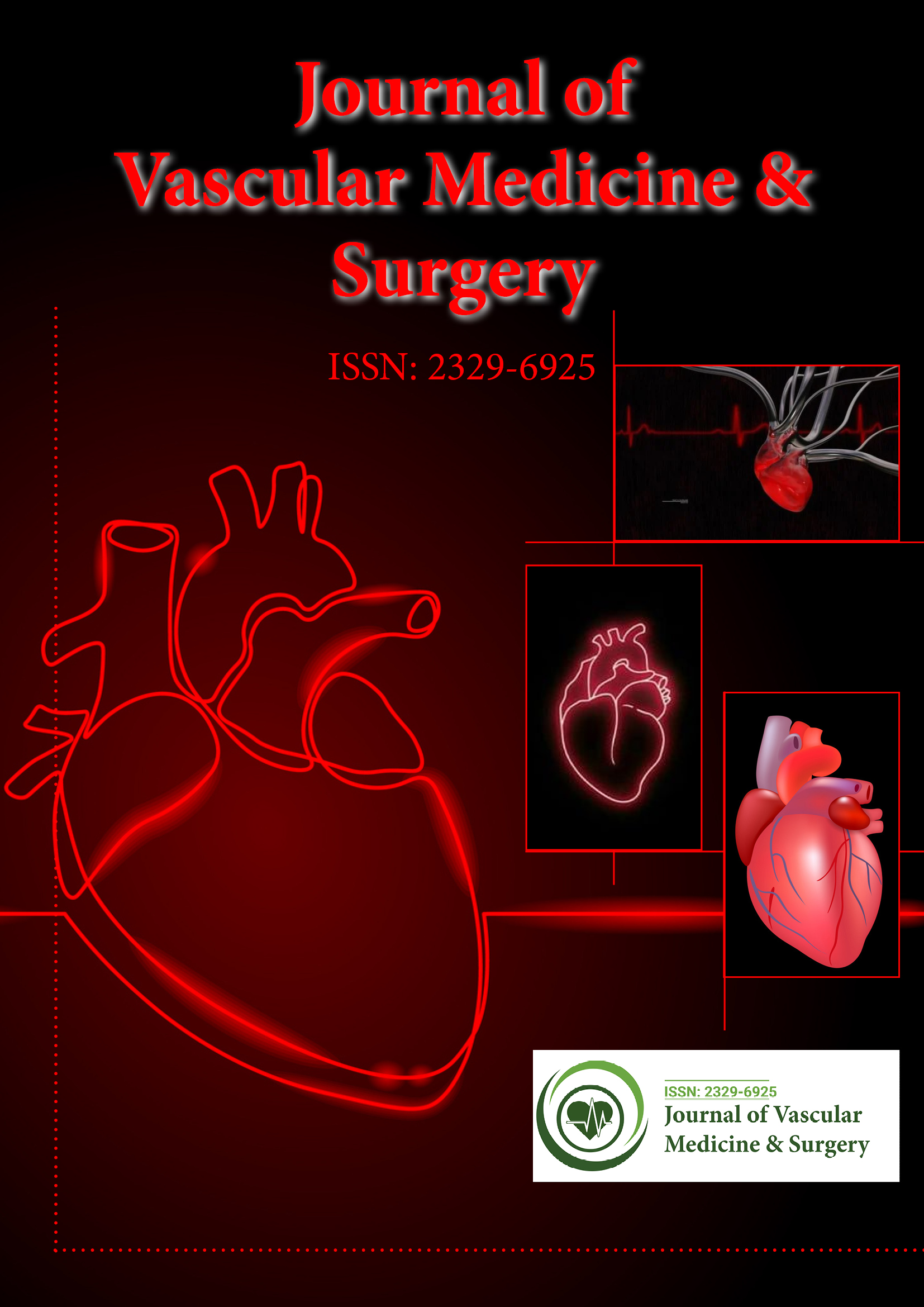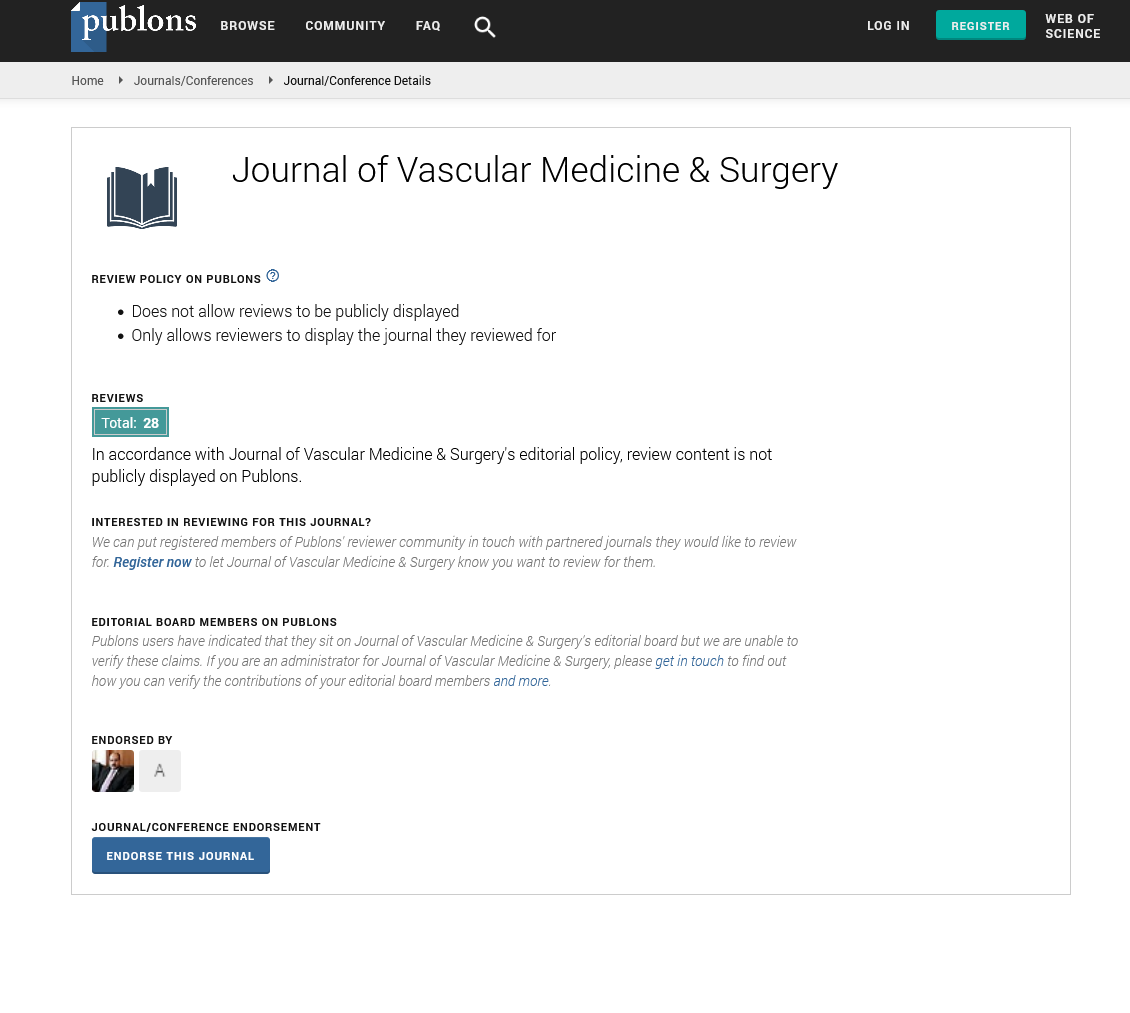Indexed In
- Open J Gate
- Academic Keys
- RefSeek
- Hamdard University
- EBSCO A-Z
- OCLC- WorldCat
- Publons
- Euro Pub
- Google Scholar
- SHERPA ROMEO
Useful Links
Share This Page
Journal Flyer

Open Access Journals
- Agri and Aquaculture
- Biochemistry
- Bioinformatics & Systems Biology
- Business & Management
- Chemistry
- Clinical Sciences
- Engineering
- Food & Nutrition
- General Science
- Genetics & Molecular Biology
- Immunology & Microbiology
- Medical Sciences
- Neuroscience & Psychology
- Nursing & Health Care
- Pharmaceutical Sciences
Opinion Article - (2025) Volume 13, Issue 8
Reimagining Diagnosis: From Risk Identification to Predictive Precision
Chester Ralph*Received: 23-Jul-2025, Manuscript No. JVMS-25-29910; Editor assigned: 25-Jul-2025, Pre QC No. JVMS-25-29910(PQ); Reviewed: 08-Aug-2025, QC No. JVMS-25-29910; Revised: 15-Aug-2025, Manuscript No. JVMS-25-29910 (R); Published: 22-Aug-2025, DOI: 10.35248/2329-6925.25.13.613
Description
Vascular disease remains one of the most formidable challenges in modern medicine, affecting millions globally and contributing significantly to stroke, heart disease, limb loss, and death. However, we are now standing on the threshold of a transformation in how we diagnose, monitor, and ultimately manage these conditions. The future of vascular disease management hinges on harnessing data, technology, and biology—not just to treat symptoms, but to predict disease progression and tailor care for every individual.
Next-gen imaging is driving earlier, more precise vascular diagnostics
The diagnostic landscape is evolving rapidly, moving away from generalized assessments toward precision medicine. Traditional methods, such as Ankle-Brachial Index (ABI) tests or Doppler ultrasound, though valuable, are being augmented by more advanced technologies. High-resolution imaging techniques, such as contrast-enhanced MRI and CT angiography, are offering more detailed, three-dimensional views of vascular structures, enabling clinicians to detect microvascular abnormalities long before symptoms appear.
Artificial Intelligence (AI) and machine learning are amplifying this potential further. Algorithms can now sift through thousands of patient records, imaging scans, and clinical parameters to detect patterns invisible to the human eye. These systems are not just diagnostic tools—they’re predictive engines. For instance, by analyzing genetic data alongside lifestyle and imaging information, AI can help determine a patient's likelihood of experiencing a vascular event, such as a stroke or aneurysm rupture, years in advance.
Moreover, the integration of wearable technology is revolutionizing how vascular risk is monitored. Smartwatches and biosensors can continuously track blood pressure, heart rate, oxygen saturation, and even detect arrhythmias, sending real-time data to healthcare providers. For high-risk patients, such surveillance acts as a digital early warning system, flagging critical changes before they escalate into emergencies.
Genomics and personalized biomarkers also hold the key to the next generation of vascular diagnostics. Understanding how genetic variations influence vascular inflammation, clotting tendencies, or lipid metabolism can help clinicians stratify patients more accurately and intervene earlier. Blood tests in development today aim to detect circulating biomarkers that reflect endothelial dysfunction or plaque instability, offering the possibility of diagnosing vascular disease at a molecular, preclinical level.
What emerges from these developments is a future in which diagnosis is not merely the identification of disease but an ongoing, dynamic assessment of risk. A future where medicine does not wait for symptoms, but moves preemptively to prevent progression. The potential to shift from episodic treatment to continuous care is not just a technological achievement—it is a conceptual breakthrough in how we approach chronic vascular conditions.
Transforming treatment toward smarter, safer, and sustainable care
As diagnostics become more precise, so too must the interventions that follow. The future of vascular disease management depends not only on early detection but also on developing treatments that are safer, smarter, and more tailored to the individual patient. A new era of therapies—minimally invasive, biologically informed, and digitally connected—is emerging to meet this demand.
Endovascular procedures are now the cornerstone of vascular treatment, allowing clinicians to intervene without the need for open surgery. These include angioplasty, stenting, atherectomy, and thrombectomy—all performed through small incisions using image-guided catheters. The next wave of these technologies is focused on enhancing durability and reducing complications. For instance, bioresorbable scaffolds that dissolve once healing is complete, and drug-coated balloons that deliver medication directly to arterial walls, are pushing the boundaries of minimally invasive care.
In tandem, regenerative medicine is gaining traction. Stem cell therapy, once experimental, is moving toward clinical application in treating critical limb ischemia and other forms of advanced vascular disease. By stimulating the growth of new blood vessels, these therapies offer hope to patients who were previously considered untreatable.
Gene therapies are also emerging as powerful tools, aiming to correct or compensate for inherited defects that predispose individuals to vascular dysfunction. Experimental treatments targeting Vascular Endothelial Growth Factor (VEGF) pathways are already demonstrating promise in clinical trials, with the potential to stimulate angiogenesis and restore perfusion in ischemic tissues.
Alongside procedural innovation, pharmacotherapy is undergoing its own transformation. The future lies in personalized medicine, where treatments are chosen based not only on diagnosis but on a patient’s genetic profile, response history, and comorbid conditions. Antiplatelet and anticoagulant therapies are being refined to minimize bleeding risk while maximizing efficacy, as are lipid-lowering drugs.
Digital health is a game-changer here. The integration of remote patient monitoring, virtual consultations, and medication adherence tools ensures that treatment does not end when the patient leaves the hospital. Digital platforms now enable clinicians to track patient progress in real time, adjust medications, recommend lifestyle changes, and even deliver behavioral support—all from a distance. This continuous feedback loop improves long-term outcomes and helps reduce hospital readmissions, making care more sustainable and cost-effective.
Conclusion
Unlocking the future potential in vascular disease management is no longer a distant vision it is an unfolding reality. The convergence of advanced diagnostics, minimally invasive treatments, digital innovation, and personalized care is transforming how we understand, prevent, and treat these complex conditions. We are moving toward a system where vascular health is monitored in real time.
Citation: Ralph C (2025). Reimagining Diagnosis: From Risk Identification to Predictive Precision. J Vasc Surg. 13:613
Copyright: © 2025 Ralph C. This is an open-access article distributed under the terms of the Creative Commons Attribution License, which permits unrestricted use, distribution and reproduction in any medium, provided the original author and source are credited.

